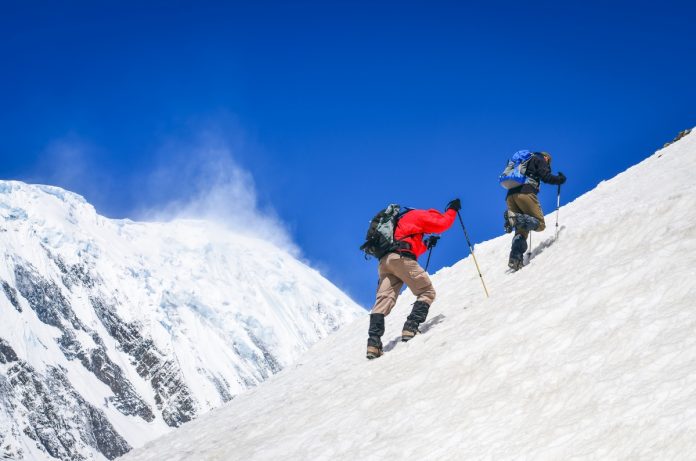Table of Contents
Overview:
Climbing a mountain is an extraordinary experience and it is even more if you are picking Nepal mountains. Nepal is a guardian of the highest Himalayan range in which the number of peaks ranging from 5000m to 8848m settle in. Thousands of mountaineers come every year to ascend one of the Nepali peaks. Some of them are professionals, some are semi-professionals and others are beginners. Yes, Nepal’s mountains are for everyone. And, if you are a beginner looking for a mountaineering guide in Nepal, you have come to the right place.
There are several mountains in Nepal that are perfect for beginning the mountaineering experience. The peaks below the height of 7000m meters are considered as the mountains for the beginners in Nepal. Island Peak climbing, Yala Peak, Mera Peak, Lobuche West Peak, and Pokalde Peak are some of those Nepali peaks for beginners.
The brief introduction and facts about these peaks and helpful guides for beginners as below. Also, don’t miss to check the mountaineering gear list listed below, it will answer you what gears you need.
Top climbing peaks for beginners in Nepal
Island Peak
If you are mountain lovers and you have never heard of Island Peak, this would be impossible. Island Peak i.e. Imja Tse is a popular climbing peak located in the famous Khumbu/Everest region just a few hills from the Chhukung Valley. The summit of Island Peak is at an altitude of 6,189m and has fascinated thousands of mountaineers to date. It is also an ultimate pick for beginners if they want to start the climbing journey from Nepal.
Island Peak climbing is a slightly technical and challenging peak than other climbing peaks. But with strong commitment and excellent preparation, anyone can achieve their feat even the beginners.
Few quick facts about Island Peak:
- Location: Solu Khumbu/Everest Region
- Height: 6,189m
- Difficulty Level: Slightly technical
- No of Days for Expedition: 1 to 2 days(from Island Peak Base Camp)
- Best Time: April to May, October to November
Mera Peak
Mera Peak(6,476m) is the highest and second-most popular trekking peak in Nepal. It is a peak with a collection of three different peaks that lie in the Everest region. The journey of Mera Peak is mostly suitable for beginners as its slightly difficult expedition can make them more skillful.
Mera Peak climbing leads you through many Himalayan villages and colorful rhododendron forests. The route of Mera Peak is not easily accessible as the Island Peak and its climb gives a feeling like an expedition rather than trekking. However, Mera peak is less technical than the Imja Tse(Island Peak). Therefore, it can be another option for beginners to pick for themselves.
Few quick facts about Mera Peak:
- Location: Makalu Barun National Park
- Height: 6,476m
- Difficulty Level: Slightly difficult
- No of Days for Expedition: 3 days
- Best Time: April to May, October to November
Lobuche East Peak
It is another popular peak that is from the lofty Everest region. Lobuche East Peak(6,119m) is a mountain summit with two peaks; Lobuche East and Lobuche West. The Lobuche West is almost impossible which makes the east face more popular. Lobuche East Peak Climbing is a mildly challenging peak that does not demand any serious training or experience.
It is a must climb trek for anyone starting the climbing journey. This peak climbing makes you visit the famous Kala Patthar and Everest Base Camp. Therefore, this peak is a complete package where you get to visit several popular stops.
Few quick facts about Lobuche East Peak:
- Location: Everest(Khumbu) region
- Height: 6,119m
- Difficulty Level: Easy
- No of Days for Expedition: 3 days
- Best Time: Mid-March to May and October to Mid-December
Yala Peak
The Yala Peak(5,520m) makes it into the list of top climbing peaks for beginners quite easily. Situated in the Langtang region of Nepal, this peak has become a scenic platform to boost the mountaineering skill. Yala Peak is one of the easiest climbing peaks of Nepal with not a single technical part while climbing. The Yala Peak climbing does not demand any prior climbing experience but you need to have sound fitness level and health.
The successful climb will provide you the breathtaking view of Shishapangma(8,013m); the highest peak in Tibet. Besides that, Langtang Lirung, Dorche Lakpa, Gangchepo, and other peaks of the Langtang region are easily accessible with eyes.
Few quick facts about Yala Peak:
- Location: Langtang region
- Height: 5,520m
- Difficulty Level: Easy
- No of Days for Expedition: 1 day
- Best Time: March to May, October to Mid-December
Pokhalde Peak
When it is about peak climbing for beginners, the Pokhalde Peak is a name not to miss out. It is another trekking/climbing peak from the Everest region which is around 12 km southwest from Mt Everest. Pokhalde Peak(5,806m) is the easiest peak to climb and perfect ground for those who want to start mountaineering with Himalayan experience. The peak does not involve any technical difficulty hence anyone with strong fitness and brief knowledge about mountains can achieve this feat. Pokhalde Peak also works as the vantage point to enjoy the Himalayas.
Few quick facts about Pokhalde Peak:
- Location: Everest region
- Height: 5,806m
- Difficulty Level: Easy
- No of Days for Expedition: 1 day
- Best Time: April to May, September to October
Quick Mountaineering tips for beginners
- Build fitness: Mountaineering is a tough thing to do therefore build strong fitness so that you can endure through any kind of difficulties during the climb. Cycling, Running, Stair Climbing, Gym Workout on a regular basis certainly improve fitness level.
- Pick your expedition: Consider what kind of peak you want to take on- difficult, technical, moderately easy, or easy. And then plan accordingly for the expedition. Think of when to start, how to start, etc.
- Take a course: Joining a course of mountaineering makes you learn everything about the mountains and you can get quick feedback in case of any doubts. You get to learn the skills by practicing and hiking around snow-covered hills. Plus, the tutor or guides experience sharing can teach much more than the course.
- Get the right mountaineering gears: It is an important thing to do, you have to arrange right gears for your mountaineering adventure. Start getting gears prior to the flight day and make sure what kind of gears will be suitable for the next climb. Try to avoid unnecessary gears which can make your backpack heavy.
- Prepare for high altitude: It is obvious that the peak lies above 3500m and anywhere in that altitude can cause altitude sickness. Take altitude sickness seriously and learn everything about it like; what are causes, symptoms, precautions, and responses.
- Build up some skills: Practice skills in a safer environment and develop those skills to boost your climbing experience. You don’t need to go to the mountains for practice skills like a crevasse rescue, ice-axe arrest, rope tying, etc. You can practice those acts in the mimic environment.
Basic Personal Mountaineering Gears for Beginners
Mountaineering Boots
A comfortable pair of mountaineering boots are the most basic gears while traveling the mountains. These mountain-specialized boots are stiffer than the normal trekking boots by which crampons easily fit in while walking on the ice.
Climbing Harness:
It is a mountaineering gear with belts and straps which holds and controls the climbers with rope while climbing. Climbing Harness is often made from gear loops and flat webbing and they are quite light, comfortable, and compact to wear on. The not-so-light harness is very uncomfortable to wear as they get a tight grip on your waist.
Ice Axe
A strong Ice Axe is what you’ll require most when you are ascending the steep trail. This gear helps you to ascend the sloped and technical parts of the mountains. The more technical and difficult peak requires two Ice-Axe.
Crampons
Mountaineering Crampons are what you put under the shoe to climb or walk snowy trails. This gear helps to hold the ground in the ice-slippery tracks. Crampons are made of aluminum or steel, the steel made crampons are durable and aluminum made are light weighted. Therefore pick what kind of Crampons you want.
Climbing Helmet
Climbing Helmet keeps your head safe while climbing in case of any stone, equipment fall. It also safeguards your head to get hurt by hitting rock or walls. Therefore, a standard climbing helmet is the first buy before any mountaineering journey.









